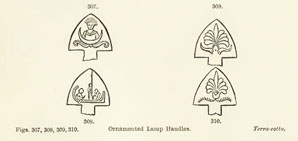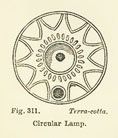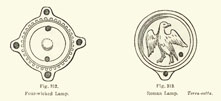Previous First Next
SALAMIS IN THE ISLAND OF CYPRUS.
BY ALEXANDER PALMA DI CESNOLÀ, F.S.A.,
page 126

These have no handles. Such a kind is shewn in the accompanying illustration. Some of the larger sized lamps, and especially those of Greek origin, have a flat, triangular handle,1 not unlike the barb of an anchor, which is either plain (fig. 306) or ornamented in various ways. Another in
the collection has two nozzles. Among those of this class in the presentcollection are, one (fig. 307) having a bust of the Moon-God placed upon a crescent enriched with spirals; another (fig.308) with a galley and mariners; a third with an antefixal ornament and two dolphins naiant (fig. 309); and a fourth (fig. 310) similar antefixal and two palm branches. Fig. 311 represents a circular lamp of the Roman period,  adorned with ten lancet-shaped cusps around its outer border, and a rosette or circular flower in the centre. This lamp,like the others, must be ascribed to a Romanperiod. Fig.312 shews an elegant lamp for four wicks, and having two infimdibula, or holes for
replenishing withoil. This was probably intended for use upon a candelabrum. Round the crater or bowl of this lamp is the limbus, or decorated border of floral or other ornament. adorned with ten lancet-shaped cusps around its outer border, and a rosette or circular flower in the centre. This lamp,like the others, must be ascribed to a Romanperiod. Fig.312 shews an elegant lamp for four wicks, and having two infimdibula, or holes for
replenishing withoil. This was probably intended for use upon a candelabrum. Round the crater or bowl of this lamp is the limbus, or decorated border of floral or other ornament.
1 One has a crescent-shaped handle, like that figured in Birch's Hist, of Ancient Pottery, New Edition, p. 506.
 Another Roman lamp of circular form (fig. 313) has an eagle rising, with the wings expanded, and the head turned over the back to the right. The eagle was a favourite subject of ornamentation among the Romans, on account of its connection with victory and military superiority. Another (fig. 314) has a lion's face upon it. The annexed woodcut shews an oval lamp (fig. 315), perhaps of the Christian period, with an ornamental device, Another Roman lamp of circular form (fig. 313) has an eagle rising, with the wings expanded, and the head turned over the back to the right. The eagle was a favourite subject of ornamentation among the Romans, on account of its connection with victory and military superiority. Another (fig. 314) has a lion's face upon it. The annexed woodcut shews an oval lamp (fig. 315), perhaps of the Christian period, with an ornamental device,

Previous First Next
|